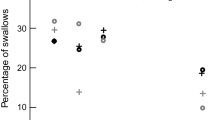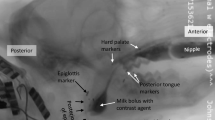Abstract
Recurrent laryngeal nerve (RLN) injury in neonates, a complication of head and neck surgeries, leads to increased aspiration risk and swallowing dysfunction. The severity of resulting sequelae range from morbidity, such as aspiration pneumonia, to mortality from infection and failure to thrive. The timing of airway protective events including laryngeal vestibule closure (LVC) is implicated in aspiration. We unilaterally transected the RLN in an infant pig model to observe changes in the timing of swallowing kinematics with lesion and aspiration. We recorded swallows using high-speed video-fluoroscopic swallow studies (VFSS) and scored them using the Infant Mammalian Penetration and Aspiration Scale (IMPAS). We hypothesized that changes would occur in swallowing kinematics (1) between RLN lesion and control animals, and (2) among safe swallows (IMPAS 1), penetration swallows (IMPAS 3), and aspiration swallows (IMPAS 7). We observed numerous changes in timing following RLN lesion in safe and unsafe swallows, suggesting pervasive changes in the coordination of oropharyngeal function. The timing of LVC, posterior tongue, and hyoid movements differed between pre- and post-lesion in safe swallows. Posterior tongue kinematics differed for post-lesion swallows with penetration. The timing and duration of LVC and posterior tongue movement differed between aspiration swallows pre- and post-lesion. After lesion, safe swallows and swallows with aspiration differed in timing of LVC, laryngeal vestibule opening, and posterior tongue and hyoid movements. The timing of thyrohyoid muscle activity varied with IMPAS, but not lesion. Further study into the pathophysiology of RLN lesion-induced swallowing dysfunction is important to developing novel therapies.












Similar content being viewed by others
References
Fink BR, Martin RW, Rohrmann CA. Biomechanics of the human epiglottis. Acta Otolaryngol. 1979;87:554–9.
Logemann JA, Kahrilas PJ, Cheng J, Pauloski BR, Gibbons PJ, Rademaker AW, et al. Closure mechanisms of laryngeal vestibule during swallow. Am J Physiol Gastrointest Liver Physiol. 1992;262:G338.
Macrae P, Anderson C, Humbert I. Mechanisms of airway protection during chin-down swallowing. J Speech Lang Hear Res. 2014;57:1251–8.
Calvo I, Sunday KL, Macrae P, Humbert IA. Effects of chin-up posture on the sequence of swallowing events. Head Neck. 2017;39:947–59.
Inamoto Y, Saitoh E, Okada S, Kagaya H, Shibata S, Ota K, et al. The effect of bolus viscosity on laryngeal closure in swallowing: kinematic analysis using 320-row area detector CT. Dysphagia. 2013;28:33–42.
Molfenter SM, Steele CM. Physiological variability in the deglutition literature: hyoid and laryngeal kinematics. Dysphagia. 2011;26:67–74.
Young JL, Macrae P, Anderson C, Taylor-Kamara I, Humbert IA. The sequence of swallowing events during the chin-down posture. Am J Speech Lang Pathol. 2015;24:659–70.
Gould FDH, Ohlemacher J, Lammers AR, Gross A, Ballester A, Fraley L, et al. Central nervous system integration of sensorimotor signals in oral and pharyngeal structures: oropharyngeal kinematics response to recurrent laryngeal nerve lesion. J Appl Physiol. 2016;120:495–502.
LaMantia A-S, Moody SA, Maynard TM, Karpinski BA, Zohn IE, Mendelowitz D, et al. Hard to swallow: developmental biological insights into pediatric dysphagia. Dev Biol. 2016;409:329–42.
Hersh C, Wentland C, Sally S, de Stadler M, Hardy S, Fracchia MS, et al. Radiation exposure from videofluoroscopic swallow studies in children with a type 1 laryngeal cleft and pharyngeal dysphagia: a retrospective review. Int J Pediatr Otorhinolaryngol. 2016;89:92–6.
German RZ, Crompton AW, Levitch LC, Thexton AJ. The mechanism of suckling in two species of infant mammal: miniature pigs and long-tailed macaques. J Exp Zool. 1992;261:322–30.
German RZ, Crompton AW, Gould FDH, Thexton AJ. Animal models for dysphagia studies: what have we learnt so far. Dysphagia. 2017. doi:10.1007/s00455-016-9778-7.
Liu S-C, Chou Y-F, Su W-F. A rapid and accurate technique for the identification of the recurrent laryngeal nerve. Ann Otol Rhinol Laryngol. 2014;123:805–10.
Gould FDH, Lammers AR, Ohlemacher J, Ballester A, Fraley L, Gross A, et al. The physiologic impact of unilateral recurrent laryngeal nerve (RLN) lesion on infant oropharyngeal and esophageal performance. Dysphagia. 2015;30:714–22.
Alvarez-Berdugo D, Rofes L, Casamitjana JF, Padrón A, Quer M, Clavé P. Oropharyngeal and laryngeal sensory innervation in the pathophysiology of swallowing disorders and sensory stimulation treatments. Ann N Y Acad Sci. 2016;1380:104–20.
Thexton AJ, Crompton AW, German RZ. EMG activity in hyoid muscles during pig suckling. J Appl Physiol. 2012;112:1512–9.
Holman SD, Waranch DR, Campbell-Malone R, Ding P, Gierbolini-Norat EM, Lukasik SL, et al. Sucking and swallowing rates after palatal anesthesia: an electromyographic study in infant pigs. J Neurophysiol. 2013;110:387–96.
Holman SD, Campbell-Malone R, Ding P, Gierbolini-Norat EM, Lukasik SL, Waranch DR, et al. Swallowing kinematics and airway protection after palatal local anesthesia in infant pigs: swallowing after palatal anesthesia. Laryngoscope. 2014;124:436–45.
Thompson C, Donley E, Stimpson C, Horne W, Vinyard C. The influence of experimental manipulations on chewing speed during in vivo laboratory research in tufted capuchins (Cebus apella). Am J Phys Anthropol. 2011;145:402–14.
Gould FDH, Yglesias B, Ohlemacher J, German RZ. Pre-pharyngeal swallow effects of recurrent laryngeal nerve lesion on bolus shape and airway protection in an infant pig model. Dysphagia. 2016;32:362–73.
German RZ, Crompton AW, Thexton AJ. Integration of the reflex pharyngeal swallow into rhythmic oral activity in a neurologically intact pig model. J Neurophysiol. 2009;102:1017–25.
Acknowledgements
The lab would like to acknowledge the CMU staff and Biomechanical Journal Club. Special thanks to Dr. Vinyard and Dr. Young, as well as everyone who worked in the German laboratory.
Funding
This work was supported by NIH R01 DC9980 NIH R01 HD088561 to R.Z. German.
Author information
Authors and Affiliations
Corresponding author
Rights and permissions
About this article
Cite this article
Gross, A., Ohlemacher, J., German, R. et al. LVC Timing in Infant Pig Swallowing and the Effect of Safe Swallowing. Dysphagia 33, 51–62 (2018). https://doi.org/10.1007/s00455-017-9832-0
Received:
Accepted:
Published:
Issue Date:
DOI: https://doi.org/10.1007/s00455-017-9832-0




